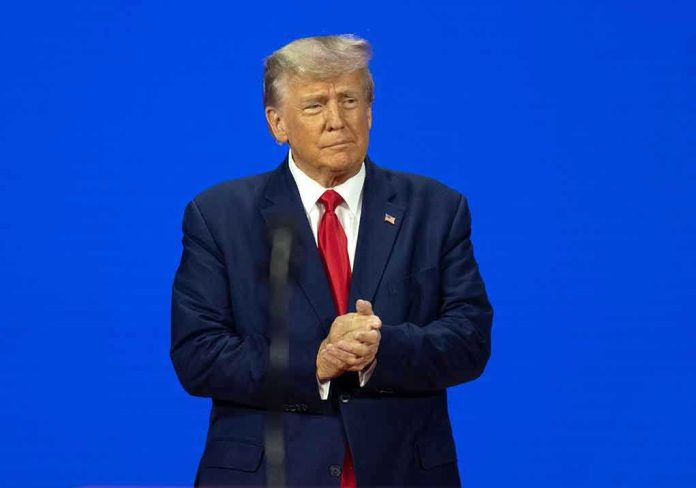
A man once spared by presidential mercy has become a cautionary tale—his journey from clemency to a 37-year prison sentence for new fraud leaves Americans questioning the very purpose of the pardon power.
Story Snapshot
- A Trump-pardoned New Jersey fraudster has just been sentenced to 37 years for a fresh, massive fraud scheme.
- The rare case of a presidentially commuted felon reoffending on such a scale has reignited national debate over clemency.
- The story scrutinizes executive power, the risk of recidivism, and the credibility of the justice system.
- Victims, prosecutors, and the public now reckon with the fallout—and the prospect of reform.
Presidential Clemency: Power, Purpose, and Pitfalls
Presidential clemency stands as one of the most potent tools in American government, designed for mercy, justice, and sometimes, political calculation. President Trump’s tenure saw a surge in high-profile commutations, often for individuals with personal connections or compelling backstories. In this environment, a New Jersey man convicted of a sweeping fraud received a commutation, regaining his freedom years ahead of schedule. Critics argued that such acts, while constitutionally sanctioned, risked undermining the deterrent power of the courts and the public’s faith in equal justice. Yet defenders insisted that clemency is a vital safety valve for correcting excess or inequity in the system. The stakes of this debate would soon escalate beyond anyone’s expectation.
Released from a lengthy federal sentence, the commuted fraudster had, by all accounts, a rare second chance. The expectation—at least the hope—was that presidential mercy could spark reform, not repeat offense. But the next chapter shattered those hopes. Within a few years, federal prosecutors uncovered a new, complex fraud operation, with the same man at its center. The scope of the scheme dwarfed his earlier conviction. Victims, both individuals and businesses, suffered severe financial harm. The courtroom drama that followed exposed not only the mechanics of deception but also the fraught question: What safeguards exist to prevent clemency from becoming a revolving door for career criminals?
The Third Strike: Legal Reckoning and Public Fallout
The federal trial that began in the wake of the new fraud case quickly drew national scrutiny. Prosecutors presented mountains of evidence detailing how the defendant, despite his high-profile break from prison, orchestrated yet another elaborate scam. The jury convicted him. The presiding judge, weighing both the scale of the crime and the defendant’s history, imposed a 37-year sentence. Such a severe penalty for a white-collar offense made headlines, but it also served as a thunderous rebuke—not just to the crime, but to the very notion that clemency guarantees rehabilitation. Victims expressed relief, but also disbelief that the system had failed to anticipate repeat harm. For federal authorities, the case became a rallying point for more stringent post-release monitoring of high-risk offenders, especially those granted extraordinary leniency.
Political ramifications quickly followed. Lawmakers and legal scholars called for a hard look at the criteria and process for granting executive clemency, particularly in complex financial crimes. Media outlets and commentators seized on the story as evidence that the system’s safety nets are too easily bypassed by determined offenders. Some voiced concern that isolated, high-profile failures could undermine the legitimate humanitarian purpose of clemency, making future presidents reluctant to intervene even in deserving cases. Others, pointing to this outcome, demanded reforms aimed at better vetting and oversight—not just of those seeking mercy, but of their actions after release.
Lessons, Reforms, and the Long Shadow of Recidivism
American history rarely records presidentially commuted or pardoned individuals returning to the headlines for fresh, major crimes. This case, with its stunning sentence and public impact, now stands as a stark warning. Legal experts stress the importance of rigorous vetting before granting clemency, especially in financial crimes where recidivism, while uncommon, can inflict immense damage. Some scholars argue that high-profile failures like this one risk overshadowing the many cases where clemency leads to productive, law-abiding lives. Yet public trust, once shaken, is difficult to restore.
New Jersey man pardoned by Trump imprisoned for third fraud conviction https://t.co/bNGIsg1fOz pic.twitter.com/nHN8JMDNDz
— New York Post (@nypost) November 19, 2025
In the short term, the convicted man’s incarceration ends his personal saga but leaves unresolved questions for policymakers and the public. Calls for reform in the clemency process have already grown louder, with proposals ranging from stricter eligibility checks to post-release supervision for those granted mercy. For victims, the sentence offers closure, though the economic and emotional scars linger. For the broader public, the story is an uncomfortable reminder that even the highest powers of the land cannot guarantee redemption. As debate rages on, one truth stands clear: the line between justice and mercy is never as bright as we wish, and every exception tests the wisdom of the rule.
Sources:
Department of Justice – Clemency Grants by President Donald J. Trump






